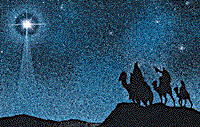

| |
| The Star of of Bethlehem | Volume 51 Number 6, November/December 1998 |
| by Anthony F. Aveni | |

"Now when Jesus was born in Bethlehem of Judea in the days of Herod the king, behold, Wise Men from the East came to Jerusalem, saying, "Where is He who has been born King of the Jews? For we have long seen His star in the East, and have come to worship Him."
| A triple conjunction (three close passes in a row) of Saturn and Jupiter in the constellation of Pisces in 7 B.C. is one astronomically sound explanation for the Star of Bethlehem. (Illustrations by Brian Sullivan) [LARGER IMAGE] |
No matter how many times Matthew's story is told, the question remains: What exactly was this star? There has been no shortage of explanations. According to one count, 250 major scholarly articles on the subject were published in the first three-quarters of this century alone. Here is a short list of nominations: It may simply have been a bright star, a supernova (an old star which, in a gravitational death spasm, blazes forth for a few months before gasping its last breath of nuclear energy), or a recurrent supernova (the same, except that several hundred years generally intervene between spasms). Some believe it was a constellation, more portentous than a single star, or a bright comet; Halley's has been mentioned. Others say the great luminary was really two comets, a meteor shower, or a fireball (a colossal meteor visible only in a small part of the world). A few have nominated the aurora borealis (northern lights). There are those who contend the star should have been called the Planet of Bethlehem--Venus hovering over the horizon or transiting the surface of the sun. Combinations of sky phenomena have been suggested, including a conjunction of two or more planets, such as the triple conjunction (three close visual passes in a row) of Saturn and Jupiter in the constellation of Pisces in 7 B.C., a planetary conjunction plus a comet, or eclipses of Saturn and Jupiter by the moon, as well as the zodiacal light, a reflection of sunlight off interplanetary particles in the plane of the planets' orbits, has been cited, as have UFOs. A second category of explanation avoids the necessity of scientific accountability by positing a theophany, an aura of light surrounding God, a supernatural radiance. A third category raises the possibility that the star is neither chronological nor literal and that identifying it either naturally or supernaturally serves no purpose, that it is "just a story."
Which of these explanations one opts for depends on who is asking the question--astronomer, theologian, or historian--and what constitutes meaning for each in the historical framework in which he or she makes the inquiry.
Dialogue With The Firmament
An oft-missing element in comprehending the story of the Star of Bethlehem is the vital role that astrology played in ancient beliefs about the natural world. Even today, a 1997 poll found that 37% of Americans believe in astrology--up from 17% in 1976. The doctrine linking celestial events to earthly activities--"as above, so below"--influenced all levels of society, from nobility to peasantry, and all forms of activity, from politics and science to medicine and agriculture. Rome at the time of nascent Christianity was no exception.
Anthony F. Aveni is the Russell B. Colgate Professor of Anthropology and Astronomy at Colgate University.
© 1998 by the Archaeological Institute of America archive.archaeology.org/9811/abstracts/star.html |
Advertisement

Advertisement






